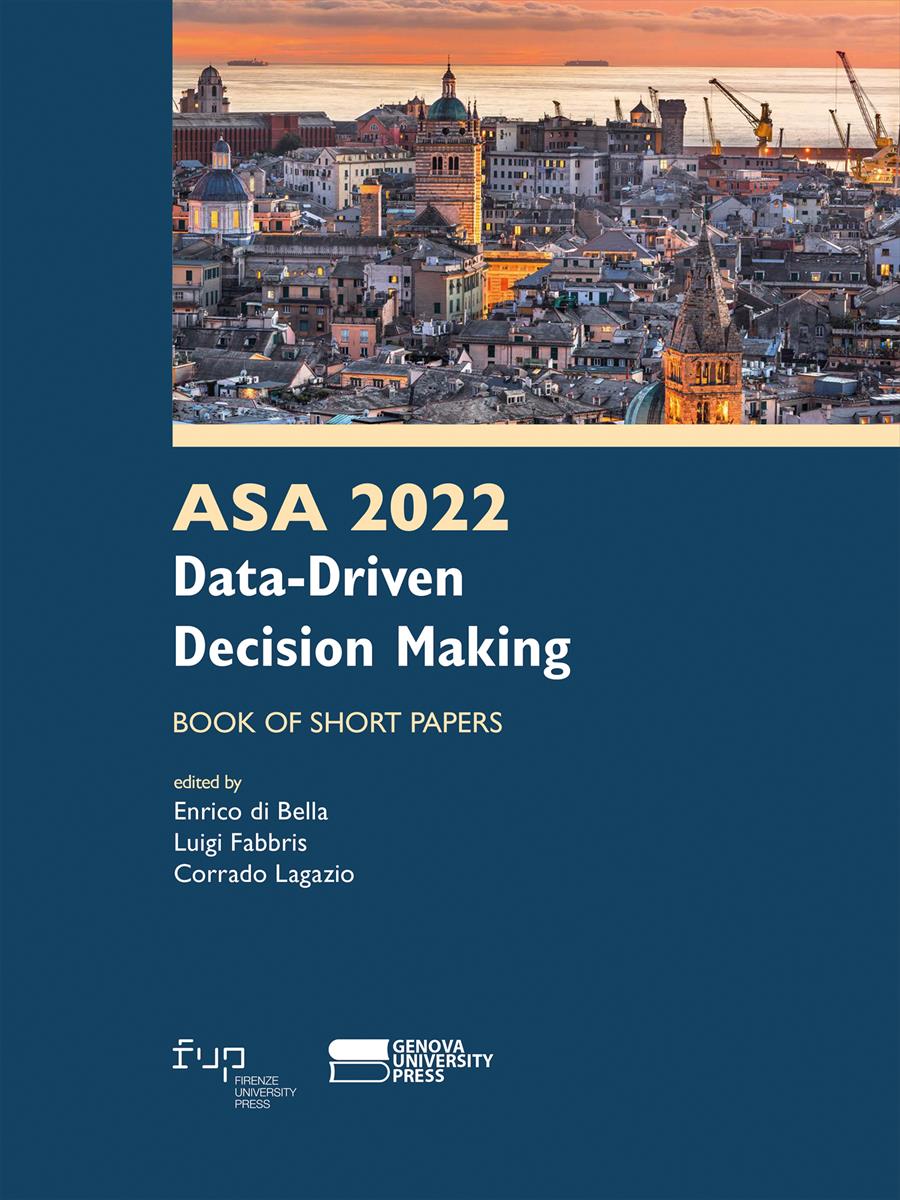- ASA 2022 Data-Driven Decision Making
- Edited by Enrico di Bella, Luigi Fabbris, Corrado Lagazio
New perspectives for the quality of sub-municipal data with the Italian permanent population and housing census
- Giancarlo Carbonetti
- Stefano Daddi
- Giampaolo De Matteis
- Marco Di Zio
- Davide Fardelli
- Raffaele Ferrara
- Fabio Lipizzi
- Enrico Orsini
- © 2023 Author(s) |
- CC BY 4.0
- DOI: 10.36253/979-12-215-0106-3.20
Over the years, official statistics have shown increasing attention to the territory in providing detailed and quality information and, in this sense, the Population and Housing Census has always guaranteed the availability of sub-municipal data useful for decision-making processes in the social, economic and environmental fields. The Istat modernization programme introduced the Permanent Census that, differently from the traditional decennial census essentially drew on collecting data from people, is strongly based on the integration of administrative and sample data, and planned for providing yearly statistical figures. This change requires new methodological and IT architectures. It is a revolution that – on the medium term – is expected to provide more stable and coherent figures at various territorial levels.In this framework, sub-municipal data derives from the integration of the Basic Register of Individuals and the Basic Register of Places. The quality of data depends on the quality of the Registers and the procedures adopted to integrate and elaborate input data. In this regard, Istat is working to improve the geocoding information and linkage procedures. One of the problem encountered is that of non-geocoded units. These are units without an allocation into an enumeration area because of problems in administrative data. Istat has studied a procedure integrating deterministic and probabilistic approaches for assigning the enumeration area to those critical units. An experimental study is carried out to evaluate the quality of the imputation procedure. In this paper, we discuss the approach adopted, the evaluation process, the results obtained and the impact on the quality of the data and the spatial analyses that can be carried out.
- Keywords:
- population census,
- administrative data,
- statistical registers,
- geo-coding,
- enumeration area,
- missing data,
- data quality,
ISTAT, Italian National Institute of Statistics, Italy - ORCID: 0000-0003-1073-9813
ISTAT, Italian National Institute of Statistics, Italy
ISTAT, Italian National Institute of Statistics, Italy
ISTAT, Italian National Institute of Statistics, Italy - ORCID: 0000-0002-6648-6934
ISTAT, Italian National Institute of Statistics, Italy
ISTAT, Italian National Institute of Statistics, Italy - ORCID: 0000-0001-7777-3835
ISTAT, Italian National Institute of Statistics, Italy
ISTAT, Italian National Institute of Statistics, Italy - ORCID: 0000-0002-3472-4344
- Comber, S., Arribas-Bel, D. (2019). Machine learning innovations in address matching: A practical comparison of word2vec and CRFs. Transactions in GIS, Vol. 23, Issue 2, pp. 334 – 348.
- Crescenzi, F., Lipizzi, F. (2020). The integration of geographic and territorial data sources into the base register of territorial and geographical entities. Statistical Journal of the IAOS, Vol. 36, no. 1, pp. 143–149.
- Curriero, F.C., Kulldorff, M., Boscoe, F.P., Klassen, A.C. (2010) Using imputation to provide location information for nongeocoded addresses. PLoS ONE, 5(2).
- Dilekli, N., Janitz, A. E., Campbell, J. E., de Beurs, K. M. (2018). Evaluation of geoimputation strategies in a large case study. International journal of health geographics, 17(1), pp. 1-13.
- Falorsi, S. (2017). Census and Social Surveys Integrated System. Note by the National Institute of Statistics of Italy, presented at the UNECE/Eurostat Group of Experts on Population and Housing Censuses, Nineteenth Meeting, Geneva, Switzerland, 4–6 Octob
- Fardelli, D., Orsini, E., Pagano, A. (2021). The address component of the Statistical Base Register of Territorial Entities. In Book of Short Papers SIS 2021, pp. 1206-1211. Pearson.
- Fortini, M., Tuoto, T. (2020). Probabilistic record linkage with less than three matching variables, in Book of Short Papers – SIS 2020, pp. 3-8. Pearson.
- Henry, K. A., Boscoe, F. P. (2008). Estimating the accuracy of geographical imputation. International journal of health geographics, 7(1), pp. 1-10.
- Little, R. J., Rubin, D. B. (2019). Statistical analysis with missing data (Vol. 793). John Wiley & Sons.
Chapter Information
Chapter Title
New perspectives for the quality of sub-municipal data with the Italian permanent population and housing census
Authors
Giancarlo Carbonetti, Stefano Daddi, Giampaolo De Matteis, Marco Di Zio, Davide Fardelli, Raffaele Ferrara, Fabio Lipizzi, Enrico Orsini
Language
English
DOI
10.36253/979-12-215-0106-3.20
Peer Reviewed
Publication Year
2023
Copyright Information
© 2023 Author(s)
Content License
Metadata License
Bibliographic Information
Book Title
ASA 2022 Data-Driven Decision Making
Book Subtitle
Book of short papers
Editors
Enrico di Bella, Luigi Fabbris, Corrado Lagazio
Peer Reviewed
Publication Year
2023
Copyright Information
© 2023 Author(s)
Content License
Metadata License
Publisher Name
Firenze University Press, Genova University Press
DOI
10.36253/979-12-215-0106-3
eISBN (pdf)
979-12-215-0106-3
eISBN (xml)
979-12-215-0107-0
Series Title
Proceedings e report
Series ISSN
2704-601X
Series E-ISSN
2704-5846
